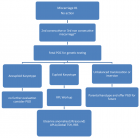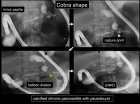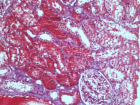Abstract
Observational Study
Causes of Coronary Angioplasty Denial in Patients Diagnosed with Significant Coronary Artery Disease in East Afghanistan
Akmal Shams, Ikramullah Ibrahimi* and Humayoun Chardiwal
Published: 30 October, 2024 | Volume 9 - Issue 3 | Pages: 153-157
Coronary Artery Disease (CAD) is a leading cause of mortality worldwide, with coronary angioplasty being a crucial intervention for patients with significant disease. This study aimed to identify and analyze the causes of coronary angioplasty denial in patients with significant coronary artery disease in Afghanistan, focusing on demographic, socioeconomic, and clinical factors.
A case-control study was conducted with a sample size of 213 patients diagnosed with significant CAD at tertiary care center in Afghanistan. The case group consisted of 106 patients who were denied angioplasty, and the control group included 107 patients who underwent the procedure. Data were collected on demographic characteristics, comorbidities, education, residence, functional status, income, and the reasons for angioplasty denial. Descriptive statistics and comparative analyses were performed to assess the factors associated with denial.
The primary reasons for angioplasty denial were financial constraints (45.3%, p < 0.001), limited hospital facilities (15.1%, p = 0.045), patient refusal (23.6%, p < 0.001), and physician preference for conservative management (12.3%, p = 0.091). Denial rates were higher among patients who were older, had multiple comorbidities, were from rural areas, and had lower education and income levels. Illiteracy and cultural beliefs contributed significantly to patient refusal, while inadequate healthcare infrastructure disproportionately affected rural populations.
Financial and infrastructural barriers are the leading causes of coronary angioplasty denial in Afghanistan, exacerbating disparities in healthcare access, particularly among low-income and rural patients. Addressing these issues through policy reforms, improved healthcare infrastructure, and targeted public health education is essential to reducing CAD-related morbidity and mortality in the country.
Read Full Article HTML DOI: 10.29328/journal.jccm.1001197 Cite this Article Read Full Article PDF
Keywords:
Coronary angioplasty; Coronary artery disease; Healthcare access; Financial barriers; Afghanistan; Patient refusal; Case-control study
References
- Khoja A, Andraweera PH, Lassi ZS, Zheng M, Pathirana MM, Ali A, et al. Risk factors for premature coronary artery disease (PCAD) in adults: a systematic review protocol. F1000Res. 2021;10:1228. Available from: https://doi.org/10.12688/f1000research.74926.1
- Oyatani K, Koyama M, Himuro N, Miura T, Ohnishi H. Characterization of prehospital time delay in primary percutaneous coronary intervention for acute myocardial infarction: analysis of geographical infrastructure-dependent and-independent components. Int J Health Geogr. 2023;22(1):7. Available from: https://doi.org/10.1186/s12942-023-00328-5
- Shams A, Ibrahimi I, Ahmadzai H. Awareness of Myocardial Infarction in Nangarhar Residents: A Community Based Study. J Cardiol Cardiovasc Med. 2024;9(2):130-134. Available from: https://doi.org/10.29328/journal.jccm.1001193
- Trani JF, Bakhshi P, Noor AA, Lopez D, Mashkoor A. Poverty, vulnerability, and provision of healthcare in Afghanistan. Soc Sci Med. 2010;70(11):1745-1755. Available from: https://doi.org/10.1016/j.socscimed.2010.02.007
- Jones-Rasmussen DM. Stress and Coping in a Global Health Crisis: A Systematic Literature Review [dissertation]. California Southern University; 2022. Available from: https://www.proquest.com/openview/a8d9a86243c11fc93ee11fb322ac16c7/1?pq-origsite=gscholar&cbl=18750&diss=y
- Henao López V, Triviño Vargas Z. Adherence to Secondary Prevention and Influential Factors in Individuals with Coronary Angioplasty. Investig Educ Enferm. 2020;38(3). Available from: https://doi.org/10.17533/udea.iee.v38n3e05
- Tonino PA, Fearon WF, De Bruyne B, Oldroyd KG, Leesar MA, Ver Lee PN, et al. Angiographic versus functional severity of coronary artery stenoses in the FAME study: fractional flow reserve versus angiography in multivessel evaluation. J Am Coll Cardiol. 2010;55(25):2816-2821. Available from: https://doi.org/10.1016/j.jacc.2009.11.096
- Bove V, Gavrilova E. Income and Livelihoods in the War in Afghanistan. World Dev. 2014;60:113-131. Available from: https://econpapers.repec.org/article/eeewdevel/v_3a60_3ay_3a2014_3ai_3ac_3ap_3a113-131.htm
- Przybojewski JZ, Weich HF. Percutaneous transluminal coronary angioplasty. A review of the literature. S Afr Med J. 1984 Jan 25;Spec No:1-22. Available from: https://pubmed.ncbi.nlm.nih.gov/6229887/
- UNDP Afghanistan. Afghanistan rural population report. United Nations Development Program; 2022. Available from: https://www.undp.org/afghanistan/publications/undp-afghanistan-2022-numbers
- Lundberg GP, Mehta LS, Volgman AS. Specialized care for women: the impact of women’s heart centers. Curr Treat Options Cardiovasc Med. 2018;20(9):76. Available from: https://doi.org/10.1007/s11936-018-0656-5
Figures:

Figure 1

Figure 2
Similar Articles
-
Short and Medium-Term Evaluation of Patients in Coronary Post-Angioplasty: Préliminary results at the Cardiology Department of the Hospital University Aristide Le Dantec of Dakar (Senegal): Study on 38 CasesDioum M*,Aw F,Masmoudi K,Gaye ND,Sarr SA,Ndao SCT, Mingou J,Ngaidé AA,Diack B,Bodian M,Ndiaye MB,Diao M,Ba SA. Short and Medium-Term Evaluation of Patients in Coronary Post-Angioplasty: Préliminary results at the Cardiology Department of the Hospital University Aristide Le Dantec of Dakar (Senegal): Study on 38 Cases. . 2017 doi: 10.29328/journal.jccm.1001006; 2: 008-012
-
Spontaneous rupture of a giant Coronary Artery Aneurysm after acute Myocardial InfarctionOğuzhan Çelik,Mucahit Yetim,Tolga Doğan,Lütfü Bekar,Macit Kalçık*,Yusuf Karavelioğlu. Spontaneous rupture of a giant Coronary Artery Aneurysm after acute Myocardial Infarction. . 2017 doi: 10.29328/journal.jccm.1001009; 2: 026-028
-
Investigation of Retinal Microvascular Findings in patients with Coronary Artery DiseaseTolga Doğan*,Osman Akın Serdar,Naile Bolca Topal,Özgür Yalçınbayır. Investigation of Retinal Microvascular Findings in patients with Coronary Artery Disease. . 2017 doi: 10.29328/journal.jccm.1001012; 2: 042-049
-
Value of electrocardiographic T wave inversion in lead aVL in prediction of Mid Left Anterior Descending Stenosis in patients with stable Coronary Artery diseaseGehan Magdy*,Awad Yousef. Value of electrocardiographic T wave inversion in lead aVL in prediction of Mid Left Anterior Descending Stenosis in patients with stable Coronary Artery disease. . 2017 doi: 10.29328/journal.jccm.1001015; 2: 056-062
-
Is secondary prevention information before discharge adequate after percutaneous coronary intervention?Catrin Henriksson*,Joep Perk. Is secondary prevention information before discharge adequate after percutaneous coronary intervention?. . 2019 doi: 10.29328/journal.jccm.1001034; 4: 012-020
-
Cardiomyopathies - The special entity of myocarditis and inflammatory cardiomyopathyFelicitas Escher*,Uwe Kühl,Dirk Lassner,Heinz-Peter Schultheiss. Cardiomyopathies - The special entity of myocarditis and inflammatory cardiomyopathy. . 2019 doi: 10.29328/journal.jccm.1001041; 4: 053-070
-
Assessment of lipid and hematological profile among blood donors in European Gaza Hospital, PalestineAhmad M Tabash*,Wesam M Afana,Abdrabbou M Elregeb,Sameer Abu Eid,Ayman M Abu Mustafa. Assessment of lipid and hematological profile among blood donors in European Gaza Hospital, Palestine. . 2019 doi: 10.29328/journal.jccm.1001043; 4: 073-079
-
Plaque morphology in diabetic vs. non diabetic patients assessed by Multi-Slice Computed Tomography coronary angiographyHesham Mohamed Aboul-Enein,Amr Elsayed El Naggar,Shereen Ibrahim Farag,Waleed Atef Ahmed Hassan*. Plaque morphology in diabetic vs. non diabetic patients assessed by Multi-Slice Computed Tomography coronary angiography. . 2019 doi: 10.29328/journal.jccm.1001057; 4: 150-155
-
Long-Term Impact of Coronary Artery Disease in Lung TransplantationWilliam S Ragalie,Nilto C de Oliveira,Richard Cornwell,Keith Meyer,James D Maloney*. Long-Term Impact of Coronary Artery Disease in Lung Transplantation. . 2019 doi: 10.29328/journal.jccm.1001073; 4: 227-232
-
Dapt ReviewKARACA Özkan*,KARASU Mehdi,KOBAT Mehmet A,KIVRAK Tarık. Dapt Review. . 2020 doi: 10.29328/journal.jccm.1001088; 5: 060-066
Recently Viewed
-
Pneumothorax as Complication of CT Guided Lung Biopsy: Frequency, Severity and Assessment of Risk FactorsGaurav Raj*,Neha Kumari,Neha Singh,Kaustubh Gupta,Anurag Gupta,Pradyuman Singh,Hemant Gupta. Pneumothorax as Complication of CT Guided Lung Biopsy: Frequency, Severity and Assessment of Risk Factors. J Radiol Oncol. 2025: doi: 10.29328/journal.jro.1001075; 9: 012-016
-
The Police Power of the National Health Surveillance Agency – ANVISADimas Augusto da Silva*,Rafaela Marinho da Silva. The Police Power of the National Health Surveillance Agency – ANVISA. Arch Cancer Sci Ther. 2024: doi: 10.29328/journal.acst.1001046; 8: 063-076
-
A Comparative Study of Serum Sodium and Potassium Levels across the Three Trimesters of PregnancyOtoikhila OC and Seriki SA*. A Comparative Study of Serum Sodium and Potassium Levels across the Three Trimesters of Pregnancy. Clin J Obstet Gynecol. 2023: doi: 10.29328/journal.cjog.1001137; 6: 108-116
-
Chaos to Cosmos: Quantum Whispers and the Cosmic GenesisOwais Farooq*,Romana Zahoor*. Chaos to Cosmos: Quantum Whispers and the Cosmic Genesis. Int J Phys Res Appl. 2025: doi: 10.29328/journal.ijpra.1001107; 8: 017-023
-
Phytochemical Compounds and the Antifungal Activity of Centaurium pulchellum Ethanol Extracts in IraqNoor Jawad Khadhum, Neepal Imtair Al-Garaawi*, Antethar Jabbar Al-Edani. Phytochemical Compounds and the Antifungal Activity of Centaurium pulchellum Ethanol Extracts in Iraq. J Plant Sci Phytopathol. 2024: doi: 10.29328/journal.jpsp.1001137; 8: 079-083
Most Viewed
-
Evaluation of Biostimulants Based on Recovered Protein Hydrolysates from Animal By-products as Plant Growth EnhancersH Pérez-Aguilar*, M Lacruz-Asaro, F Arán-Ais. Evaluation of Biostimulants Based on Recovered Protein Hydrolysates from Animal By-products as Plant Growth Enhancers. J Plant Sci Phytopathol. 2023 doi: 10.29328/journal.jpsp.1001104; 7: 042-047
-
Sinonasal Myxoma Extending into the Orbit in a 4-Year Old: A Case PresentationJulian A Purrinos*, Ramzi Younis. Sinonasal Myxoma Extending into the Orbit in a 4-Year Old: A Case Presentation. Arch Case Rep. 2024 doi: 10.29328/journal.acr.1001099; 8: 075-077
-
Feasibility study of magnetic sensing for detecting single-neuron action potentialsDenis Tonini,Kai Wu,Renata Saha,Jian-Ping Wang*. Feasibility study of magnetic sensing for detecting single-neuron action potentials. Ann Biomed Sci Eng. 2022 doi: 10.29328/journal.abse.1001018; 6: 019-029
-
Pediatric Dysgerminoma: Unveiling a Rare Ovarian TumorFaten Limaiem*, Khalil Saffar, Ahmed Halouani. Pediatric Dysgerminoma: Unveiling a Rare Ovarian Tumor. Arch Case Rep. 2024 doi: 10.29328/journal.acr.1001087; 8: 010-013
-
Physical activity can change the physiological and psychological circumstances during COVID-19 pandemic: A narrative reviewKhashayar Maroufi*. Physical activity can change the physiological and psychological circumstances during COVID-19 pandemic: A narrative review. J Sports Med Ther. 2021 doi: 10.29328/journal.jsmt.1001051; 6: 001-007

HSPI: We're glad you're here. Please click "create a new Query" if you are a new visitor to our website and need further information from us.
If you are already a member of our network and need to keep track of any developments regarding a question you have already submitted, click "take me to my Query."























































































































































